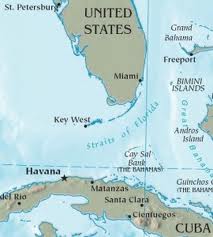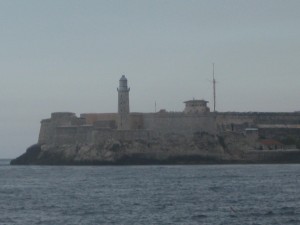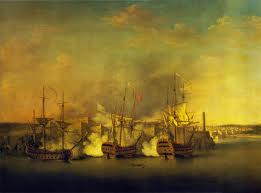
The troops disembarked some distance east and began marching; meanwhile, the warships made for Havana’s harbor. The Morro Castle soon came into our view, an immense, seemingly impenetrable stone fortress rising from the east heights as if it had been hewn out of the cliff… (from Barbados Bound, formerly published as Star-Crossed.)
A decade ago when I was writing Star-Crossed, my first historical novel, I became intrigued (obsessed, actually) with Havana. In 1762, the year of the British invasion, Havana was a Spanish colonial city of some thirty thousand inhabitants – more populous than Philadelphia, which at the time the largest city in colonial North America. Because of its great bay, one of the largest in the world, it served the Spaniards as a rendezvous for their galleons coming from Central and South America, laden with silver and gold. The British succeeded in capturing their prize, the port city of Havana, but they returned it after only ten months of occupation, according to the terms of the Treaty of Paris that ended the Seven Years War. The hard-won prize of Havana was a pawn, returned to Spain and with it Louisiana as compensation for other losses, from France. In return, Spain handed over to Britain all its possessions east of the Mississippi, including Florida. Many Brits regarded this as poor compensation, and I’m sure Patricia and her crewmates would agree. But then Cuba has always long been the object of desire by many, including the United States who tried to buy her from Spain.
A few weeks ago I actually got to visit Cuba, which, as a citizen of the U.S.A. (land of the free?) is not so easy to do. At least, not legally! The U.S. Treasury Department controls those Americans given permission to visit our neighbors. I have an official U.S. document I’m supposed to keep for like, five years, in case I get investigated. Investigated for what? Smoking a cigar and drinking Havana Club rum? I can go to Vietnam without such permission and I can go to China, Laos and North Korea (if they’ll let me in) but I can’t go to Cuba except with “approved cultural institutions” who promise to keep me way too busy doing cultural activities to have any time to say, take salsa lessons, smuggle cigars or otherise pump big bucks into the Cuban economy. But, I digress.
On the chartered jet flying south out of Miami I sat on the port side of the aircraft, my face pressed against the plexiglass, watching our progress over the long chain of islets known as the Florida Keys; irregular pieces of various shades of green that seemed to float on the turquoise water. Bob and I had talked about sailing to Cuba, before he was diagnosed with kidney failure, and I had gone so far as to buy a cruising guide to the island (guides are plentiful since everyone else on the planet is allowed to go there). Instead, we went with the Art Institute of Chicago on a group tour, the focus of which was contemporary Cuban art. Fortunately, I was also able to see a few of the historical sites I wanted to visit.
Iconic sentinel of the harbor mouth, the Morro Castle (technically, the Castillo do los Tres Reyes del Morro), was designed by the Italian military architect Giovanni Bautista Antonelli in 1589 to detect the approach of pirates and enemy invaders. The oldest fortress still standing today is the Castillo de la Real Fuerza, begun in 1558 to protect the city after a succesful raid by the French privateer Jacques de Sores in 1555. Today both fortresses are museums, as is the Fortaleza de San Carlos de la Cabana, the largest fortress in the Western Hemisphere, built in response to the British invasion of 1762. Every evening at 9 pm a volley of cannon shots is fired by a group of young soldiers of the Revolutionary Armed Forces, dressed in 18th century uniforms, carrying on the tradition from colonial times when the volley announced the access to the bay had been blocked by a chain raised up from the bottom of the channel to prevent invaders from entering the harbor. In 1762 tge British got around this by landing troops both east and west of the city, and by bombarding the forts from outside the harbor.
… By now the plan was no longer a secret from the crew; the entire fleet was to sail up the Straits of Bahama to take Havana, Spain’s port city on the northwest coast of Cuba. To take it by surprise, as no one in their wildest dreams would expect an attack from that direction. The Straits was a passage that hadn’t been used for over a century, studded as it was with cays and unmarked reefs and rife with treacherous currents. It was an audacious plan…
For my husband and I, it was a short flight. Compared to Pocock’s hazardous journey, our trip from Miami to Havana took about forty minutes. From the window I could see the north shore and the infamous Bahamian Channel that Pocock’s fleet had navigated, thanks to the Richmond and Captain Elphinstone’s crew.
On the twenty-seventh we entered the Straits. The Richmond led the way, her small boats going ahead, taking soundings and marking the channel with buoys. Captain Elphinstone had an old Spanish chart, booty from one of the galleons Admiral Anson captured years ago. But the soundings were old and he was wise not to depend on it… We entered waters that were studded with low-lying cays. Dangerous waters on all sides. The officers paced the decks like cats, twisting their spyglasses anxiously in their hands. All eyes were on the alert for the ruffled appearance of shoal water and the lighter turquoise color of shallows; all ears were listening for the warning cries from the lookouts posted in the tops of every mast…
…The troops disembarked some distance east and began marching; meanwhile the warships made for Havana’s harbor. The Morro Castle soon came into our view, an immense, seemingly impenetrable stone fortress rising from the east heights as if it had been hewn out of the cliff.
Across the bay to the west was the governor’s fort. Inside the walls, a cluster of elegant mansions, tiles gleaming in the sun. Above the roofs rose the spire of a massive cathedral, nearly as formidable as the castle on the opposite shore. Beyond the fort’s protective wall, a sprawl of wooden buildings and rutted roads disappeared into the dense tropical brush. This was Havana, the richest city in the New World, and our intended prize…
Barbados Bound will be published later this summer by Fireship Press. For those who have read Star-Crossed, it is essentially the same story – but with a few edits. First of all, I had the chance to correct a couple of anachronisms. For example, Patricia occasionallyused the word “battleship” which was not yet used, instead of “ship of the line”, or “warship.” I had Brian Dalton smoking his pipe aloft in the rigging, which would not have been allowed, nor wise. And I made mention of the miracle of Lourdes, which was perhaps the biggest faux pas of all, since that occurred nearly 100 years later! Mea culpa. I thank the alert readers who showed me the error of my words and ways, you know who you are!
I also took the opportunity to add back into the story some words and phrases edited out for the young adult market Star-Crossed was geared for. In fact, Star-Crossed was not my first or second choice for a title, it was the editorial and marketing people at Knopf who came up with that.
By the way, I’m not done with Cuba. I’m going back, one way or another. And so is Patricia, posing as Patrick, in the next book, By a Yankee Moon. That’s the manuscript I’m writing now. In Yankee Moon the war is over and the British no longer occupy the Spanish city but trade, both legal and illegal, between the Habaneros and the American Colonies is thriving. Patricia has a chance to make some money on this run – if she can dodge the British naval ships which are now seizing colonial vessels suspected of smuggling sugar and molasses. And then there is the chance meeting with a certain wily French privateer-turned-smuggler who knows she is a woman…

